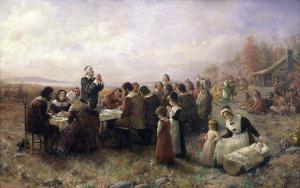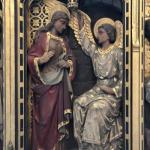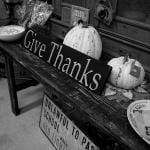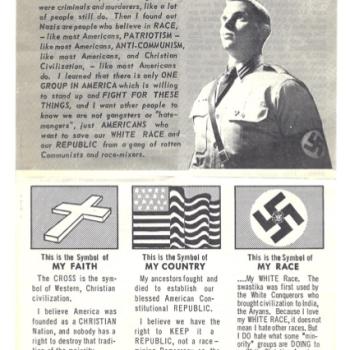Thanksgiving is a good holiday for historians, because it gives us a ready opportunity to deflate myths. This task doesn’t tend to win historians many friends, but it’s an important part of the job, and someone has to do it.
The “First Thanksgiving” celebrated by Pilgrims and Indians in 1621? Not a thanksgiving and certainly not the first thanksgiving in what became the United States.

The only source for the “thanksgiving” is a letter written by Edward Winslow, published in the colony’s first promotional tract (commonly called Mourt’s Relation):
the harvest being gotten in, our governor sent four men on fowling, that so we might after a more special manner rejoice together, after we had gathered the fruit of our labors, they four in one day killed as much fowl, as with a little help beside, served the company almost a week, at which time amongst other recreations, we exercised our arms, many of the Indians coming amongst us, and among the rest their greatest King Massasoit, with some ninety men, whom for three days we entertained and feasted, and they went out and killed five deer, which they brought to the plantation… by the goodness of God, we are so far from want.
Like other puritans, the Pilgrims understood a thanksgiving as a specially appointed day of prayer, on which a community would thank God for a particular blessing. Such occasions included badly needed rain, the passing of an epidemic, or a military victory. While it is possible that Governor William Bradford and Elder William Brewster appointed such a day after the harvest, there is no mention of it in Winslow’s account or in Bradford’s history.
As Charles Blow noted in the New York Times this week (the historical accuracy of the piece does not match its fervor), many paintings of the feast show pious Pilgrims seated around a table, with a few Indian men, women, and children in the background. Or perhaps the Pilgrims share some of their harvest with the people who had helped them learn how to plant it. What Winslow describes is quite different. It is a harvest celebration. Indian men – Winslow does not mention any women and children — showed up after they heard their strange new English allies firing their guns. The Wampanoags outnumbered their English counterparts.
The details of the celebration, however, do not matter as much as its meaning. Plymouth has long been a sunny contrast to the bloody early history of Jamestown, in which settlers groused, starved, and quickly descended into vicious warfare against the Powhatans. In 1622, the Powhatans killed several hundred English in an uprising. By contrast, the Pilgrims and the Wampanoags became friends, symbolized by their shared thanksgiving meal.
Again, it is not hard for historians to puncture these myths. See Blow’s essay, or Peter Mancall’s recent CNN article. Or better yet, read David Silverman’s just-published This Land Is Their Land (full review coming soon). Silverman laments that elementary-school commemorations of Thanksgiving make it seem as if the Wampanoags were quite content for the English to take over their land. Moreover, Americans have lionized the Pilgrims for their stolid perseverance through their deadly first winter at Plymouth (a plight they themselves created), while paying very little attention to the traumas experienced by the Wampanoags in the two decades prior to the arrival of the Mayflower. Yes, half of the Pilgrims died that first winter. Wampanoag communities suffered far more severe losses through epidemics unleashed by European-born microbes. Also, several English explorers and traders had kidnapped Natives, in one case carrying twenty men off to the slave markets of Spain.
Given these experiences with Europeans, the Wampanoags were hardly thrilled to see the Pilgrims come ashore (Plymouth was built at the site of a Native community wiped out by the epidemics). They understood that the English were dangerous and treacherous. At the same time, Native peoples wanted to trade, and Massasoit Ousamequin wanted new allies in the face of his people’s decimation. The alliance with the Pilgrims was a strategic choice.
While both Ousamequin’s people and the Pilgrims benefited from the alliance at first, one hardly needs the expertise of historians to recognize that in the long run it worked out much better for the English settlers of Plymouth Colony. By the end of the seventeenth century, the English had colonized and conquered most Wampanoag land. In the wake of what is most commonly called King Philip’s War, the English enslaved and exported hundreds of Wampanoag men, women, children. They reduced many others to servitude and debt peonage.
Most Americans today are not thinking about Plymouth in 1621. Although exceptions remain, with each passing year fewer American schoolchildren dress up as Pilgrims and Indians and act out historically inaccurate versions of the “First Thanksgiving.” In early twenty-first century America, Thanksgiving is a day of family, gluttony, football, and online shopping.
In what popular imagination of early English settlement Americans possess, though, the Pilgrims remain a cheery counterpoint to both Jamestown and Massachusetts Bay. And the Pilgrim-Wampanoag alliance, although increasingly frayed, did hold for three quarters of a century. If one peers farther beyond the 1621 harvest celebration, the history of colonization and conquest in Plymouth Colony is not so cheery after all.
So what are historians to do with the “First Thanksgiving” myth? Well, every year they can write op-eds and books explaining its inaccuracies. Not a thanksgiving, and not the first. A harvest festival and “diplomatic event” (to use Andrew Lipman’s term). And a long-term disaster for the Wampanoags. Historians have known these things for a long time, and yet Pilgrim myths prove pretty stubborn.
For the last seven years, I’ve been posting on Thanksgiving at The Anxious Bench. I’ve written about George Washington’s 1789 Thanksgiving proclamation, Jesus’s distribution of “free food” to people in his day, and about how thankful I am to be a professional historian. At some point, I decided that if I had to keep writing about Thanksgiving each year, I would have to write a book about the Pilgrims and Plymouth Colony. Since then, I’ve written about the Pilgrims giving thanks when they reached the tip of Cape Cod and about the 1676 day of thanksgiving. On the latter occasion, the severed head of Philip (the son of Ousamequin) arrived in Plymouth just as settlers emerged from worship. There were other thanksgivings as well, such as when the town of Scituate observed a thanksgiving in December 1636. On a frigid morning, worshipers endured several hours of psalm-singing, prayers, and sermon, then feasted, “the poorer sort being invited of the richer.”
In other words, the history of Plymouth Colony is not a simple story of two peoples forming a friendship and feasting together. Nor is it a simple story of English invaders stealing land and killing those who got in their way. There is some truth in both of these stories, but there is much more underneath the myths that Americans have told about the Pilgrims and the First Thanksgiving.













